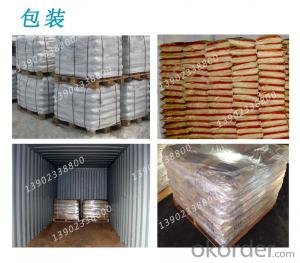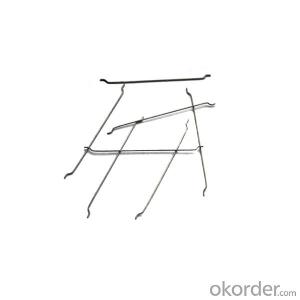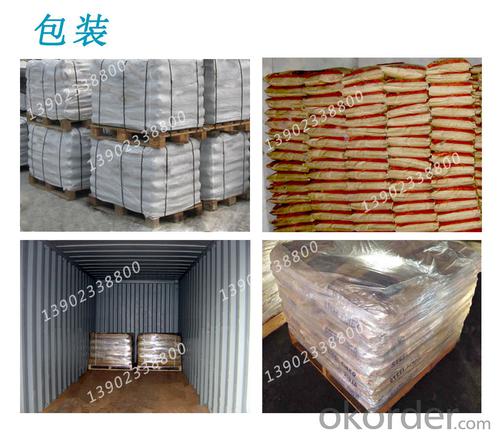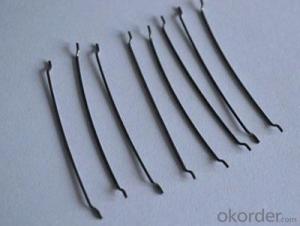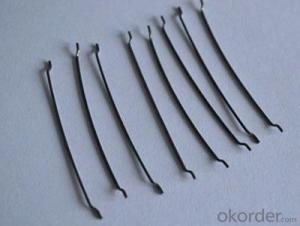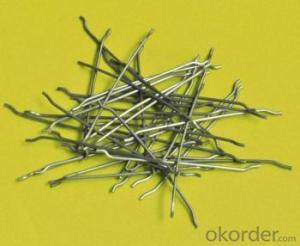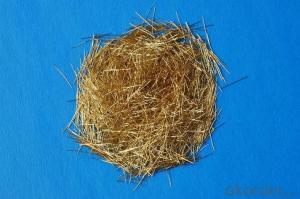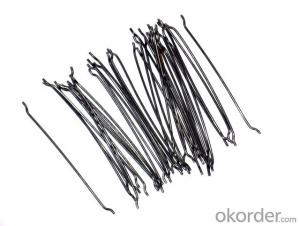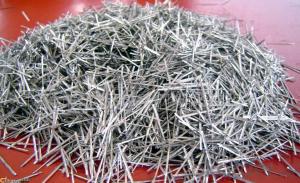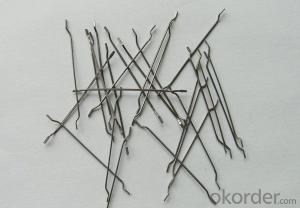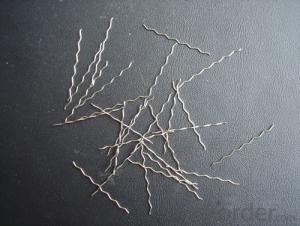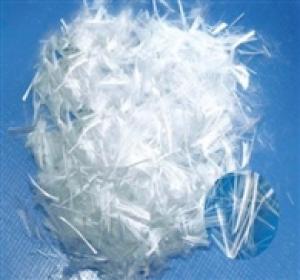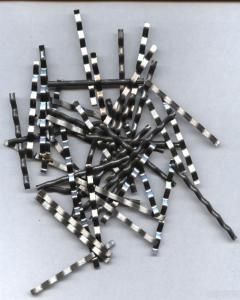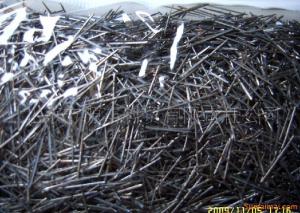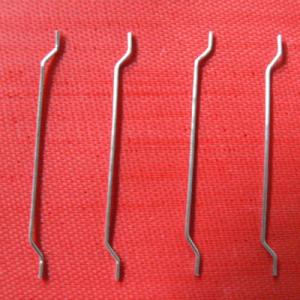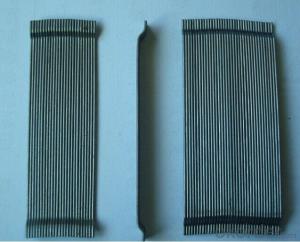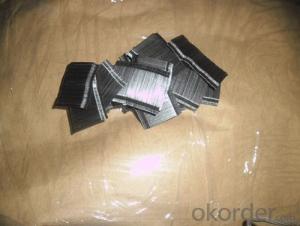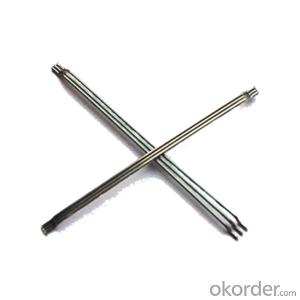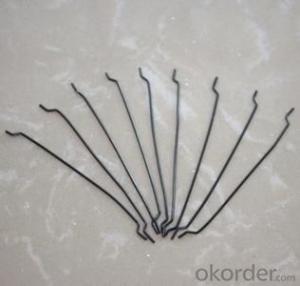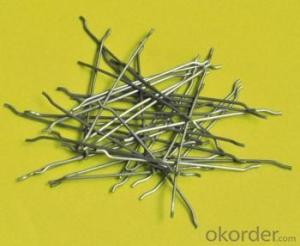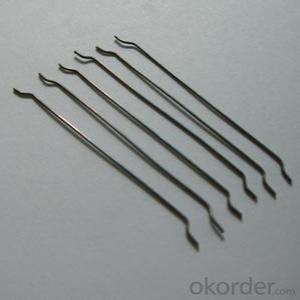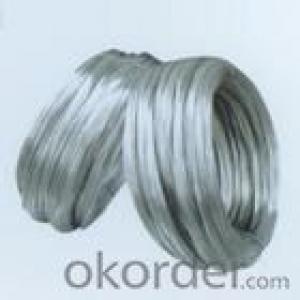Steel price per ton concrete steel fiber
- Loading Port:
- Tianjin
- Payment Terms:
- TT OR LC
- Min Order Qty:
- 1 m.t.
- Supply Capability:
- 600 m.t./month
OKorder Service Pledge
Quality Product, Order Online Tracking, Timely Delivery
OKorder Financial Service
Credit Rating, Credit Services, Credit Purchasing
You Might Also Like
Quick Details
Place of Origin: Tianjin, China (Mainland)
Model Number: 0.6
Material: Steel
Production Process: Cold drawn
Fiber Lengh: 35
Type: 1
Compressive Strength: >1200MPa
Aspect ratio: 60
Standard: ASTM A820M-11
Section Shape: Circular
Application: Concrete Reinforcement
Product Application: Industrial Floor
Packaging & Delivery
| Packaging Details: | 20 kg/Bag,50 bags/Pallet or 1,000kg/ Bulk Bag |
|---|---|
| Delivery Detail: | 1 Month |
Product Description
| Diameter | 0.60 | mm | 0.02 | in |
| Length | 35.00 | mm | 1.37 | in |
| Aspect Ratio | 58 | |||
| Tensile strength | 1200 MPa | |||
| Type | Cold drawn Steel Fiber | |||
| End | Hooked-end Steel Fiber | |||
| Glued/Loose | Glued Steel Fiber | |||
| Bending Angle | 45°(min.30°) | |||
| Usage & Performance | Floor:Trafficked areas and Industrial floors | |||
| Shotcrete :Slope stabilization and Final lining | ||||
| Precast concrete:Pipe and Railway sleepers | ||||
| Packing | Standard Export Pallet Packing | Bag Packing | 20 kg/Bag,50 bags/Pallet | |
| Bulk Packing | 1,000kg/ Bulk Bag | |||
| Loading Quantity | 20’GP | 20-25 Tonne/Tonnes | ||
| 40’GP | 25-27 Tonne/Tonnes | |||
| 40’HQ | 25-27 Tonne/Tonnes | |||
| MOQ | 1 kg for trial order | |||
| Supply Ability | 10,000 Tonne/Tonnes per Year | |||
| Payment Terms | T/T or L/C at sight | |||
| Delivery Time | Within 15 days after receiving deposit or original L/C at sight | |||
| Certification | ISO9001:2000, CE, | |||
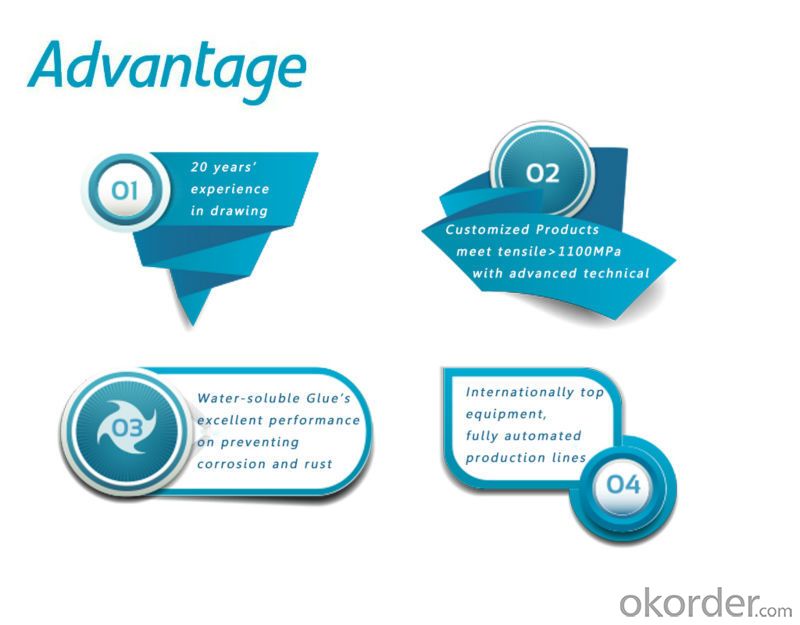
| Product | Diameter | Length mm/in | Aspect Ratio | Type | Packing |
| G-6030 | 0.5 mm (0.0197 in) | 30 mm (1.1811 in) | 60 | Glued | 20 kg/Bag, or 1,000kg/ Bulk Bag |
| G-6535 | 0.55 mm (0.0217 in) | 35 mm (1.3780 in) | 65 | Glued | 20 kg/Bag, or 1,000kg/ Bulk Bag |
| G-6035 | 0.6 mm (0.0236 in) | 35 mm (1.3780 in) | 60 | Glued | 20 kg/Bag, or 1,000kg/ Bulk Bag |
| G-8060 | 0.75 mm (0.0295 in) | 60 mm (2.3622 in) | 80 | Glued | 20 kg/Bag, 50 bags/Pallet |
| G-6060 | 0.9 mm (0.0354 in) | 60 mm (2.3622 in) | 60 | Glued | 20 kg/Bag, 50 bags/Pallet |
| G-6030 | 0.5 mm (0.0197 in) | 30 mm (1.1811 in) | 60 | Loose | 20 kg/Bag, or 1,000kg/ Bulk Bag |
| G-6535 | 0.55 mm (0.0217 in) | 35 mm (1.3780 in) | 65 | Loose | 20 kg/Bag, or 1,000kg/ Bulk Bag |
| G-6035 | 0.6 mm (0.0236 in) | 35 mm (1.3780 in) | 60 | Loose | 20 kg/Bag, or 1,000kg/ Bulk Bag |
| G-8060 | 0.75 mm (0.0295 in) | 60 mm (2.3622 in) | 80 | Loose | 20 kg/Bag, 50 bags/Pallet |
| G-6060 | 0.9 mm (0.0354 in) | 60 mm (2.3622 in) | 60 | Loose | 20 kg/Bag, 50 bags/Pallet |
- Q: Can melt extract stainless steel fiber be used in precast tunnel portals?
- Yes, melt extract stainless steel fiber can be used in precast tunnel portals. The stainless steel fiber provides reinforcement and enhances the overall strength and durability of the precast concrete, making it suitable for use in tunnel portals where there may be high levels of stress and potential for cracking.
- Q: How does the size and shape of melt extract stainless steel fiber affect its performance?
- The performance of melt extract stainless steel fiber is greatly influenced by its size and shape in different applications. Firstly, the fiber's surface area and volume are impacted by its size, which in turn affects its bonding strength with other materials. Smaller fibers generally have a larger surface area, allowing for stronger adhesion and better reinforcement of composite materials. Furthermore, the fiber's mechanical properties, such as tensile strength and ductility, are also influenced by its size. Smaller fibers tend to have higher tensile strength and increased flexibility, making them suitable for applications requiring improved structural integrity and resistance to deformation. Additionally, the performance of melt extract stainless steel fiber is dependent on its shape. Fibers with irregular or jagged shapes exhibit enhanced interlocking capabilities, enabling them to provide better mechanical anchorage within the matrix material. This improved interlocking mechanism enhances the fiber's ability to distribute stress and resist crack propagation, thereby increasing the overall durability and toughness of the composite material. On the other hand, fibers with a more regular or smooth shape offer advantages in terms of flowability and dispersibility during the manufacturing process. These fibers tend to exhibit better homogeneity and uniform distribution within the matrix material, resulting in improved mechanical properties and overall performance. In conclusion, the performance of melt extract stainless steel fibers is significantly influenced by their size and shape. Manufacturers can optimize the fiber's bonding strength, mechanical properties, and overall effectiveness in various applications, such as reinforcement in concrete, thermal insulation, or electrical conductivity, by carefully selecting the appropriate size and shape.
- Q: Can melt extract stainless steel fiber enhance the resistance of concrete to chemical attack?
- Concrete's resistance to chemical attack can be enhanced by melt extract stainless steel fiber. Stainless steel fibers are well-known for their excellent corrosion resistance, durability, and high melting point. By adding these fibers to concrete, they function as reinforcement, increasing its overall strength and resistance to various forms of degradation, including chemical attack. Chemical attack on concrete occurs when aggressive substances, such as acids, alkalis, or salts, come into contact with the concrete surface. This can result in the deterioration of the concrete, including loss of strength, cracking, and eventual failure. However, by incorporating melt extract stainless steel fibers into the concrete mix, the concrete's resistance to chemical attack is significantly improved. The stainless steel fibers create a network within the concrete, which serves as an additional barrier against the penetration of aggressive chemicals. This network helps prevent the diffusion of ions and the entry of moisture, both of which are crucial factors in chemical attack. Additionally, the stainless steel fibers function as reinforcement, enhancing the overall durability and strength of the concrete. Moreover, melt extract stainless steel fibers possess a high melting point, enabling them to withstand the elevated temperatures that can arise during chemical reactions. This ensures that the fibers do not melt or deteriorate when exposed to aggressive chemicals, guaranteeing their effectiveness in enhancing the concrete's resistance. In conclusion, the addition of melt extract stainless steel fiber to concrete significantly improves its resistance to chemical attack. These fibers' corrosion resistance, durability, and high melting point make them an effective reinforcement against aggressive substances, enhancing the concrete's overall durability and lifespan.
- Q: What are the properties of melt extract stainless steel fiber?
- Melt extract stainless steel fiber has several key properties that make it a highly desirable material in various applications. Firstly, it possesses excellent resistance to high temperatures, making it suitable for use in extreme heat environments. This property allows the stainless steel fiber to maintain its structural integrity and performance even under intense heat conditions. Secondly, melt extract stainless steel fiber exhibits high tensile strength, making it incredibly durable and resistant to breakage or deformation. This property is crucial in applications where the fiber may be subjected to high levels of stress or strain. Additionally, melt extract stainless steel fiber has exceptional corrosion resistance, thanks to its chromium content. This property ensures that the fiber remains resistant to rust, oxidation, and other forms of chemical degradation. Consequently, the stainless steel fiber can be used in harsh environments, including marine or industrial settings where exposure to corrosive substances is common. Another important property of melt extract stainless steel fiber is its electrical conductivity. Due to its metallic nature, the fiber allows for the efficient transfer of electrical currents. This makes it valuable in applications that require electrical grounding or electromagnetic shielding. Moreover, melt extract stainless steel fiber is highly versatile and can be easily incorporated into various materials and structures. It can be blended with concrete, polymers, or other materials to enhance their mechanical properties, such as flexural strength, impact resistance, and crack resistance. This versatility makes it suitable for a wide range of industries, including construction, aerospace, automotive, and textile. In summary, melt extract stainless steel fiber possesses properties such as high temperature resistance, high tensile strength, corrosion resistance, electrical conductivity, and versatility. These properties contribute to its widespread use in diverse applications where strength, durability, and performance under challenging conditions are essential.
- Q: Can melt extract stainless steel fiber be used in tunnel segment construction?
- Melt extract stainless steel fiber is indeed applicable for tunnel segment construction. It possesses remarkable characteristics such as high tensile strength, corrosion resistance, and durability. These attributes render it suitable for reinforcing concrete in tunnel segments, as they must endure substantial loads and challenging environments commonly encountered in tunnel construction. By incorporating stainless steel fibers into the concrete mixture, its flexural strength can be enhanced, cracking can be mitigated, and overall structural integrity can be improved. Moreover, the melt extract manufacturing process guarantees a consistent dispersion of the fibers and secure bonding with the concrete matrix, thereby augmenting their efficacy in tunnel segment construction.
- Q: What is the effect of melt extract stainless steel fiber on the crack width in shotcrete?
- The use of melt extract stainless steel fiber in shotcrete can effectively reduce crack width by enhancing the tensile strength and ductility of the material. The fibers act as reinforcement, distributing the stress more evenly, and preventing the propagation of cracks. This results in improved crack resistance and overall durability of the shotcrete structure.
- Q: Can melt extract stainless steel fiber be used in parking garage structures?
- Indeed, parking garage structures can utilize melt extract stainless steel fiber. This type of fiber, derived from stainless steel, is frequently employed as a reinforcement material in concrete to bolster its sturdiness and longevity. By incorporating melt extract stainless steel fiber, the resistance of concrete structures to cracking, impact, and corrosion can be notably enhanced, rendering it an optimal choice for parking garages. This particular type of stainless steel fiber has been specially engineered to possess exceptional tensile strength and impeccable adhesion with concrete, ensuring the stability and durability of the parking garage. Moreover, the stainless steel composition provides resistance against rusting and deterioration, a vital characteristic for structures exposed to harsh environmental elements, such as parking garages. All in all, the utilization of melt extract stainless steel fiber in parking garage structures can profoundly augment their structural integrity and lifespan.
- Q: How does melt extract stainless steel fiber affect the shrinkage cracking of concrete?
- The shrinkage cracking of concrete can be significantly reduced by the addition of melt extract stainless steel fiber. Acting as reinforcement, these fibers improve the overall tensile strength and ductility of the material when added to the concrete mixture. When concrete cures, it undergoes shrinkage as excess water evaporates. This shrinkage can cause cracks to form, compromising the structural integrity of the concrete. However, the inclusion of melt extract stainless steel fibers helps to alleviate the occurrence of shrinkage cracking. These fibers are evenly distributed throughout the concrete matrix, creating a three-dimensional network that strengthens the material. Consequently, the fibers effectively distribute the tensile stresses caused by shrinkage, decreasing the likelihood of crack formation. Additionally, the stainless steel fibers exhibit high resistance to corrosion, a common problem in concrete structures. This corrosion resistance ensures that the fibers maintain their structural integrity over time, providing long-term reinforcement against shrinkage cracking. In conclusion, the incorporation of melt extract stainless steel fiber in concrete significantly reduces shrinkage cracking. These fibers enhance the material's tensile strength and ductility, distribute tensile stresses induced by shrinkage, and offer long-term protection against corrosion. Ultimately, this reinforcement mechanism improves the durability and performance of concrete structures, minimizing the risk of shrinkage cracking.
- Q: Is melt extract stainless steel fiber suitable for use in airport runway construction?
- Yes, melt extract stainless steel fiber is suitable for use in airport runway construction. It offers excellent durability, high tensile strength, and resistance to corrosion, making it an ideal choice for withstanding heavy aircraft traffic and harsh weather conditions. Additionally, the fiber enhances the overall performance and lifespan of the runway, ensuring safe and efficient operations at the airport.
- Q: Does melt extract stainless steel fiber improve the fire resistance of concrete?
- Yes, melt extract stainless steel fiber does improve the fire resistance of concrete. When added to concrete, stainless steel fibers act as reinforcement, enhancing the strength and durability of the material. During a fire, these fibers help to slow down the spread of heat and prevent the concrete from cracking or spalling. Additionally, the high melting point of stainless steel ensures that it retains its structural integrity even under extreme temperatures. This improves the overall fire resistance of the concrete, making it a more reliable and safe construction material in fire-prone areas.
Send your message to us
Steel price per ton concrete steel fiber
- Loading Port:
- Tianjin
- Payment Terms:
- TT OR LC
- Min Order Qty:
- 1 m.t.
- Supply Capability:
- 600 m.t./month
OKorder Service Pledge
Quality Product, Order Online Tracking, Timely Delivery
OKorder Financial Service
Credit Rating, Credit Services, Credit Purchasing
Similar products
Hot products
Hot Searches
Related keywords
